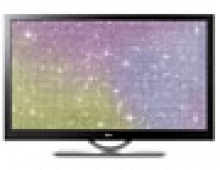
Even higher-definition TVs due soon
New HDTV models from Sharp and other vendors promise crisper images, once 1080p content arrives.
As DigitMag reports...
The great high-definition television set currently available in Japan and the US may no longer be the best on the block. While most high-definition sets sold today have native screen resolutions that support the 720p high-def screen format (720 lines of progressive-scan video), a new contingent of 40-inch and larger sets offer native support for the 1080p format. The effect of the higher resolution is debatable now, but these sets will eventually mean improved pictures.
Sharp already has 1080p sets in its popular Aquos lines of LCD TVs - but only in the newer 45-inch models. Samsung has promised to deliver a 56-inch 1080p version of its sleek pedestal-mounted DLP (Digital Light Processing) set this spring, followed in June by a 67-inch tabletop DLP set. And LG has announced both a 62-inch 1080p DLP set and a 55-inch 1080p LCD TV.
Clarity's cost
Not surprisingly, these high-res sets will command a premium price: Samsung's 56-inch 1080p DLP is expected to cost over £3,000, compared with the price of about £2,000 for its 56-inch 720p version. But even budget vendors such as the Syntax Group will be selling 1080p products.
With progressive scanning, the set draws each of the 720 or 1080 lines in an image one after the other. By contrast, sets that use the interlaced method (signified with an "i" after the number of lines of resolution) scan every other line, so only half of the set's lines are "firing" at a given time. Interlacing allows for greater resolution at lower bandwidth, but it can produce flicker if you're watching sports or other content showing rapid movement.
Any set with native support for at least 720p is considered an HDTV. But will HD programs viewed on a 1080p set look better than they do on today's 720p models? The answer depends on the type of HD program. No HD shows are currently broadcast in 1080p; some are recorded in 720p, others in 1080i.
A 720p set de-interlaces the 1080i image and then scales down the 1080 horizontal lines to 720 lines; a 1080p set only has to do the first step, so it should produce a better-looking image. But 720p content is likely to look better on a natively 720p set than on a 1080p model that has to scale the image up.
Samsung and other vendors say that regardless of the content type, the higher screen resolution of 1080p sets will still produce images superior to those of lower-resolution HDTVs, especially on larger sets - in much the way that a blown-up image from a 6-megapixel camera looks better than a blown-up image from a 2-megapixel camera.
In a few years, the argument may become moot: Experts agree that 1080p content will look better on a 1080p set, and at some point Hollywood is expected to start delivering 1080p movies on high-definition discs. Also, new video compression technology could eventually allow 1080p broadcasts. So buying a 1080p set, if your budget permits, might prove a foresighted means of future-proofing. But for at least the next couple of years, having one will probably matter only to people who want state-of-the-art technology, regardless of the cost.
Sky will launch HDTV services in 2006, probably before the football World Cup kicks off in Germany on June 9 2006. NTL has recently been trialing HDTV services over broadband Internet connections.
The great high-definition television set currently available in Japan and the US may no longer be the best on the block. While most high-definition sets sold today have native screen resolutions that support the 720p high-def screen format (720 lines of progressive-scan video), a new contingent of 40-inch and larger sets offer native support for the 1080p format. The effect of the higher resolution is debatable now, but these sets will eventually mean improved pictures.
Sharp already has 1080p sets in its popular Aquos lines of LCD TVs - but only in the newer 45-inch models. Samsung has promised to deliver a 56-inch 1080p version of its sleek pedestal-mounted DLP (Digital Light Processing) set this spring, followed in June by a 67-inch tabletop DLP set. And LG has announced both a 62-inch 1080p DLP set and a 55-inch 1080p LCD TV.
Clarity's cost
Not surprisingly, these high-res sets will command a premium price: Samsung's 56-inch 1080p DLP is expected to cost over £3,000, compared with the price of about £2,000 for its 56-inch 720p version. But even budget vendors such as the Syntax Group will be selling 1080p products.
With progressive scanning, the set draws each of the 720 or 1080 lines in an image one after the other. By contrast, sets that use the interlaced method (signified with an "i" after the number of lines of resolution) scan every other line, so only half of the set's lines are "firing" at a given time. Interlacing allows for greater resolution at lower bandwidth, but it can produce flicker if you're watching sports or other content showing rapid movement.
Any set with native support for at least 720p is considered an HDTV. But will HD programs viewed on a 1080p set look better than they do on today's 720p models? The answer depends on the type of HD program. No HD shows are currently broadcast in 1080p; some are recorded in 720p, others in 1080i.
A 720p set de-interlaces the 1080i image and then scales down the 1080 horizontal lines to 720 lines; a 1080p set only has to do the first step, so it should produce a better-looking image. But 720p content is likely to look better on a natively 720p set than on a 1080p model that has to scale the image up.
Samsung and other vendors say that regardless of the content type, the higher screen resolution of 1080p sets will still produce images superior to those of lower-resolution HDTVs, especially on larger sets - in much the way that a blown-up image from a 6-megapixel camera looks better than a blown-up image from a 2-megapixel camera.
In a few years, the argument may become moot: Experts agree that 1080p content will look better on a 1080p set, and at some point Hollywood is expected to start delivering 1080p movies on high-definition discs. Also, new video compression technology could eventually allow 1080p broadcasts. So buying a 1080p set, if your budget permits, might prove a foresighted means of future-proofing. But for at least the next couple of years, having one will probably matter only to people who want state-of-the-art technology, regardless of the cost.
Sky will launch HDTV services in 2006, probably before the football World Cup kicks off in Germany on June 9 2006. NTL has recently been trialing HDTV services over broadband Internet connections.



















